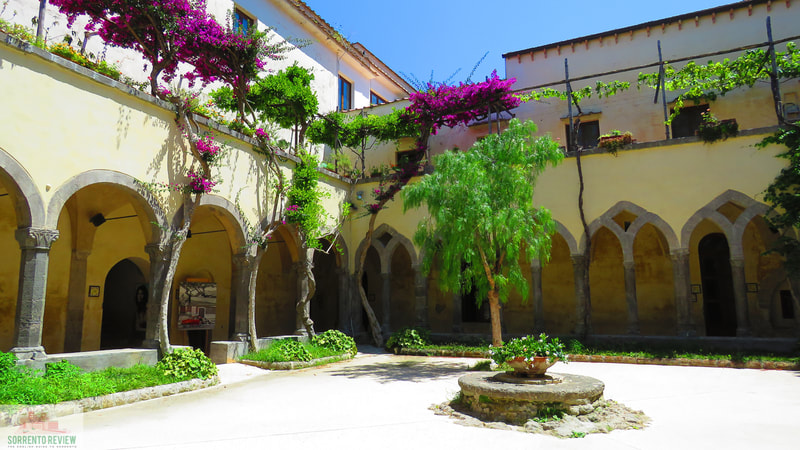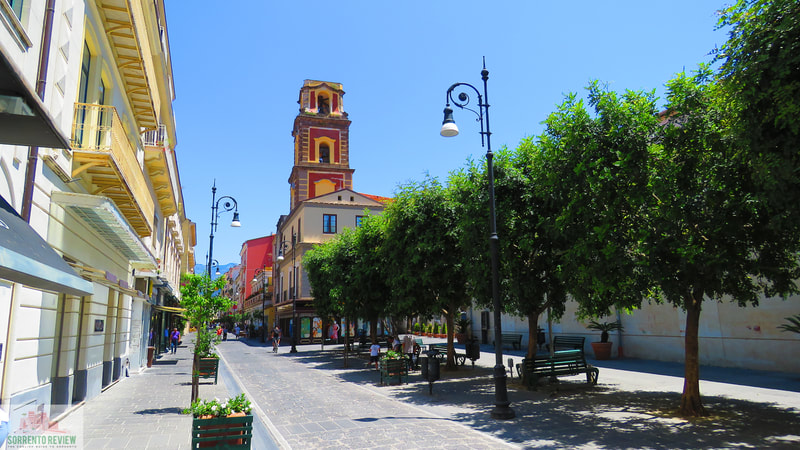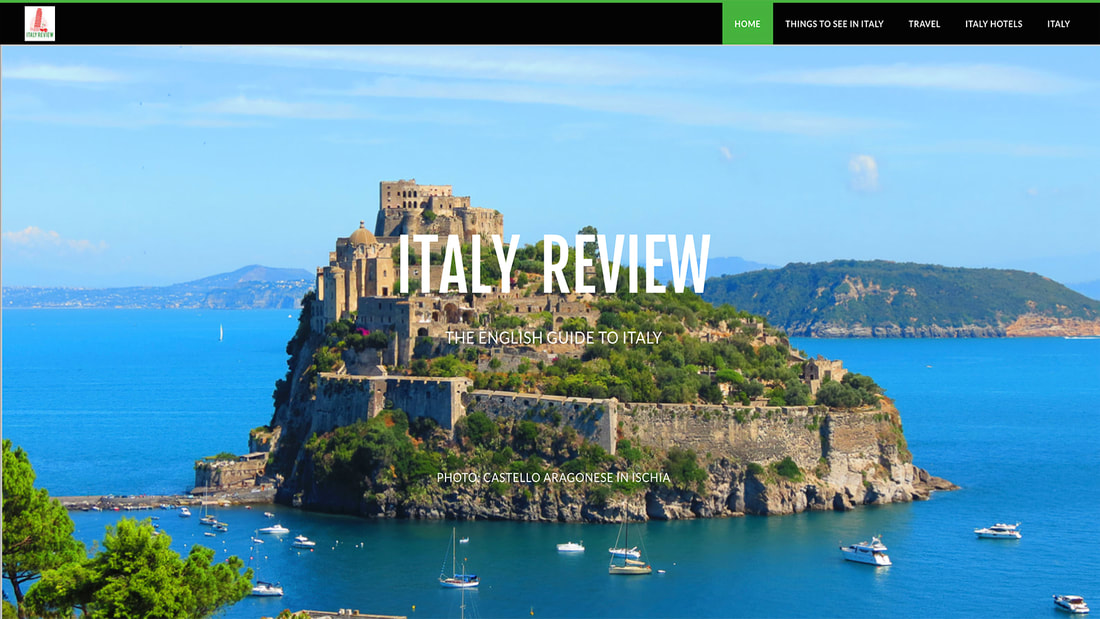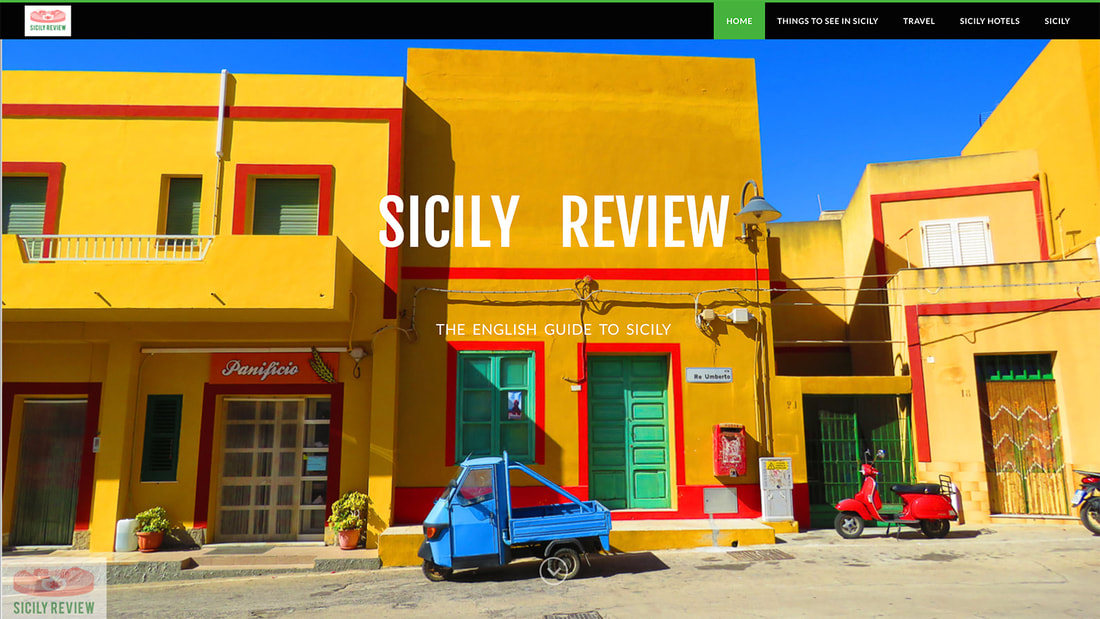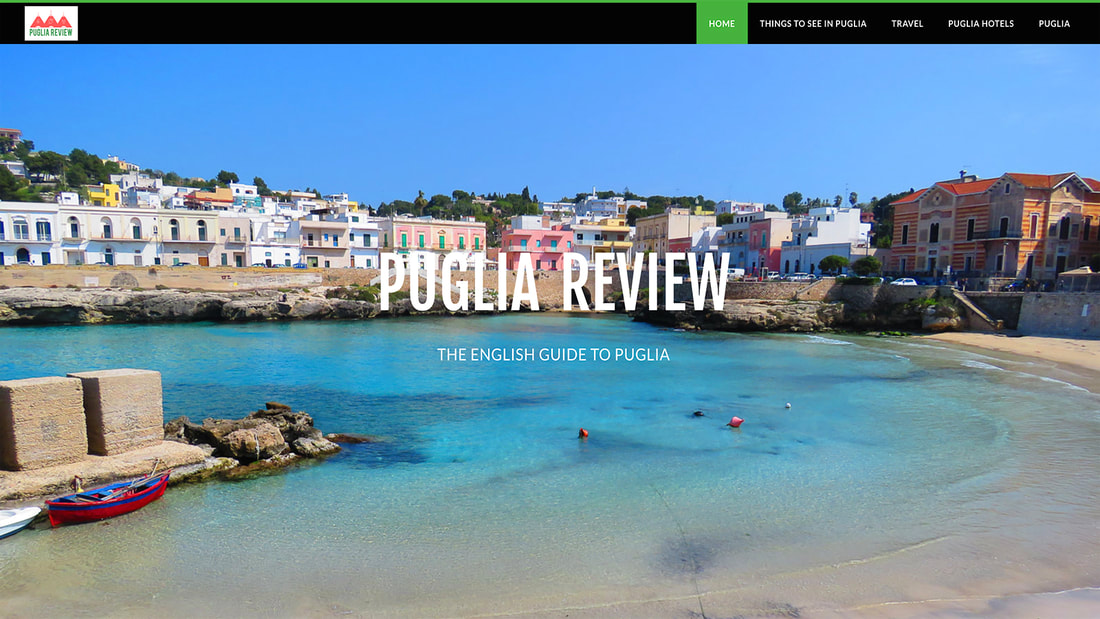Sorrento
Latest update: 8 January 2024
|
Situated on the peninsula that bears its name at the southern end of the Bay of Naples, the seaside town of Sorrento has been luring visitors since antiquity when Homer's Sirens did their best to tempt passing sailors.
It was the Greeks that established the settlement first known as Surreo, meaning "flow together" in the 6th century BC. One theory is that the name was in reference to two ancient rivers that once met in the town, evidence of which comes from the gorge that dissects Sorrento in the middle, now called Via Luigi de Maio. |
Related links
|
|
By the time the Romans came along centuries later, the town had been renamed Surrentum, and sometimes referred to as the variant Sirrentum, meaning "Land of Sirens". To this day, many locals call the town "Surriento", which comes from the Neapolitan dialect; the term is glorified in the 1902 Ernesto and Giambattista de Curtis brothers song "Torna a Surriento", which you can listen to on Youtube in the box to the left.
It's one of those songs that you somehow know without knowing you knew (if that makes sense). It's also one of the most popular traditional songs that you'll hear on nights out throughout Naples and its surrounding area. |
Sorrento's stunning cliff-top position has moved many artists and writers to action over the years. Norwegian author Henrik Ibsen famously penned Peer Gynt here and one of the town's most famous sons is the poet Torquato Tasso, born in 1544 and celebrated with a statue in the square named after him: Piazza Tasso.
For any exploration of Sorrento, Piazza Tasso is just about the best place to start. This is the busiest intersection in the town, a place of hustle and bustle where motorists circle the plant pot at its centre that doubles-up as a mini-roundabout, while tourists make their way to and from the Belle Epoque hotels just a short walk away. It's also one of the best places in southern Italy for simple people-watching as there's always something going on here.
Piazza Tasso is flanked on two of its sides by the main shopping street Corso Italia. The road stretches along an east-west axis that leads up to Sorrento's train station, a 5 minute walk walk away to the east of the square, while in the other direction, the mostly-pedestrianised section of the street is even more popular with its proliferation of shops, bars and restaurants. It's also the home to the town's most important religious building: Sorrento Cathedral.
The area just to the north of this western section of Corso Italia is one of the most fascinating in the town, and certainly one of the most popular. Here, the streets are narrow enough to allow only pedestrians and conceal a wide range of shops where you can buy local specialities such as the drink Limoncello, or explore the traditional arts & crafts.
Sorrento is a traditional centre of marquetry, a process whereby layers of polished wood are used to create trinkets and luxury household items. Marquetry is also referred to as "inlaid wood craft", and the industry is celebrated in the town's Museo Bottega della Tarsia Lignea, situated on a side street just off Corso Italia. Aside from the museum, the narrow streets such as Via San Cesareo are peppered with antique shops selling the products, as well as a number of ceramic and lace items which have also traditionally been produced here.
The tight web of narrow lanes that make up the old town, along with the wide-open spaces of Piazza Tasso and Corso Italia, are hugely popular on balmy summer's evenings for the Passeggiata. The post or pre-dinner walk is one of the most enjoyable aspects of life in Sorrento but there's much to do in the daytimes as well.
When it's hot, everyone wants to be close to the water and Sorrento doesn't disappoint here. Take a stroll towards the sea from Piazza Tasso and you soon find yourself at Villa Comunale Park. From the promenade balcony of the park you get one of the best views of the town: looking out across the Bay of Naples with Mount Vesuvius in the distance, while immediately below the crystalline waters of the sea are populated by a series of beach clubs. There are no better places than these to cool off; although there is little in the way of sand, the wooden decking areas allow easy access in and out of the water, along with all the facilities you would wish for such as toilets, changing rooms and on-site restaurants.
The main area of beach clubs lies just to the west of Marina Piccola. You can enjoy the views by walking down a path that lines the cliff to eventually reach the establishments below, or alternatively, take advantage of the Sorrento Lift which is situated in Villa Comunale Park and saves those legs, particularly for the way back up to the town centre. On your way to and from Villa Comunale, there's every chance you'll be able to get a few peeks at a wedding taking places at the gorgeous Church and Cloisters of San Francesco. Weddings are very easy to organise in Sorrento and this is the most popular venue for them.
Marina Piccola's prime function is that of the town's main port. From here you can sail across to the islands of Capri and Ischia or further down the littoral to the Amalfi Coast. These are just some of the most popular excursions that you can take from Sorrento, rivalled only by the proximity of the archaeological sites of Pompeii and Herculaneum on the mainland which can easily be reached by train.
A second marina area in the town offers something a little different and is an absolute must or any visit to Sorrento. To the east of Marina Piccola and its beach clubs, you'll find Marina Grande. A rudimentary knowledge of Italian will show that these are the "big" and "small" ports but this can cause some confusion as one isn't noticeably bigger than the other. Marina Grande is more the "old port"; take the steps that lead down, passing under the famous Greek Gate that dates back to the 4th century BC, and the spectacle of the harbour all of a sudden opens up in front of you. This is one of the best places to eat with a variety of freshly-caught fish dominating the menus. There are also a number of beach clubs here that work in a similar way to those of Marina Piccola.
Without question, the primary focus of the Sorrento Peninsula is Sorrento itself but there are some great little towns and villages to visit all across it. You can take advantage of local buses, hire boats, paddle canoes or even just walk to a number of locations such as the nearby Bagni di Regina Giovanna or further afield to the towns of Meta, Vico Equense and Marina della Lobra to name just a few. If you're able to hire a car then Sorrento really opens up with opportunities to explore the Peninsula or east, across its hilly spine and over to the Amalfi Coast Road which takes around 45 minutes to reach.
Almost all international visitors to Sorrento come via Naples International Airport which is situated around 50 kilometres north of the town and takes about an hour to reach by car. It's also possible to take a hydrofoil to Naples city centre and then take a taxi, but the more traditional route is by road. We ourselves at Sorrento Review offer private transfers to and from the airport, as well as a number of boat tours and taxi tours of the Amalfi Coast.
Visitors from the USA and other countries outside Europe can find flights to Rome work out cheaper than flights to Naples. From Rome it's straightforward to travel by train to Naples and then onto Sorrento. Alternatively, we offer private transfers from either of Rome's airports to Sorrento by taxi.
For advice on any of our services or for making the most of your visit to Sorrento, just drop us a line at [email protected] or via our popular Facebook page which is regularly updated by our resident Sorrento specialist: Eddie Best. You can find a link to the Facebook account at the bottom of this page.
For any exploration of Sorrento, Piazza Tasso is just about the best place to start. This is the busiest intersection in the town, a place of hustle and bustle where motorists circle the plant pot at its centre that doubles-up as a mini-roundabout, while tourists make their way to and from the Belle Epoque hotels just a short walk away. It's also one of the best places in southern Italy for simple people-watching as there's always something going on here.
Piazza Tasso is flanked on two of its sides by the main shopping street Corso Italia. The road stretches along an east-west axis that leads up to Sorrento's train station, a 5 minute walk walk away to the east of the square, while in the other direction, the mostly-pedestrianised section of the street is even more popular with its proliferation of shops, bars and restaurants. It's also the home to the town's most important religious building: Sorrento Cathedral.
The area just to the north of this western section of Corso Italia is one of the most fascinating in the town, and certainly one of the most popular. Here, the streets are narrow enough to allow only pedestrians and conceal a wide range of shops where you can buy local specialities such as the drink Limoncello, or explore the traditional arts & crafts.
Sorrento is a traditional centre of marquetry, a process whereby layers of polished wood are used to create trinkets and luxury household items. Marquetry is also referred to as "inlaid wood craft", and the industry is celebrated in the town's Museo Bottega della Tarsia Lignea, situated on a side street just off Corso Italia. Aside from the museum, the narrow streets such as Via San Cesareo are peppered with antique shops selling the products, as well as a number of ceramic and lace items which have also traditionally been produced here.
The tight web of narrow lanes that make up the old town, along with the wide-open spaces of Piazza Tasso and Corso Italia, are hugely popular on balmy summer's evenings for the Passeggiata. The post or pre-dinner walk is one of the most enjoyable aspects of life in Sorrento but there's much to do in the daytimes as well.
When it's hot, everyone wants to be close to the water and Sorrento doesn't disappoint here. Take a stroll towards the sea from Piazza Tasso and you soon find yourself at Villa Comunale Park. From the promenade balcony of the park you get one of the best views of the town: looking out across the Bay of Naples with Mount Vesuvius in the distance, while immediately below the crystalline waters of the sea are populated by a series of beach clubs. There are no better places than these to cool off; although there is little in the way of sand, the wooden decking areas allow easy access in and out of the water, along with all the facilities you would wish for such as toilets, changing rooms and on-site restaurants.
The main area of beach clubs lies just to the west of Marina Piccola. You can enjoy the views by walking down a path that lines the cliff to eventually reach the establishments below, or alternatively, take advantage of the Sorrento Lift which is situated in Villa Comunale Park and saves those legs, particularly for the way back up to the town centre. On your way to and from Villa Comunale, there's every chance you'll be able to get a few peeks at a wedding taking places at the gorgeous Church and Cloisters of San Francesco. Weddings are very easy to organise in Sorrento and this is the most popular venue for them.
Marina Piccola's prime function is that of the town's main port. From here you can sail across to the islands of Capri and Ischia or further down the littoral to the Amalfi Coast. These are just some of the most popular excursions that you can take from Sorrento, rivalled only by the proximity of the archaeological sites of Pompeii and Herculaneum on the mainland which can easily be reached by train.
A second marina area in the town offers something a little different and is an absolute must or any visit to Sorrento. To the east of Marina Piccola and its beach clubs, you'll find Marina Grande. A rudimentary knowledge of Italian will show that these are the "big" and "small" ports but this can cause some confusion as one isn't noticeably bigger than the other. Marina Grande is more the "old port"; take the steps that lead down, passing under the famous Greek Gate that dates back to the 4th century BC, and the spectacle of the harbour all of a sudden opens up in front of you. This is one of the best places to eat with a variety of freshly-caught fish dominating the menus. There are also a number of beach clubs here that work in a similar way to those of Marina Piccola.
Without question, the primary focus of the Sorrento Peninsula is Sorrento itself but there are some great little towns and villages to visit all across it. You can take advantage of local buses, hire boats, paddle canoes or even just walk to a number of locations such as the nearby Bagni di Regina Giovanna or further afield to the towns of Meta, Vico Equense and Marina della Lobra to name just a few. If you're able to hire a car then Sorrento really opens up with opportunities to explore the Peninsula or east, across its hilly spine and over to the Amalfi Coast Road which takes around 45 minutes to reach.
Almost all international visitors to Sorrento come via Naples International Airport which is situated around 50 kilometres north of the town and takes about an hour to reach by car. It's also possible to take a hydrofoil to Naples city centre and then take a taxi, but the more traditional route is by road. We ourselves at Sorrento Review offer private transfers to and from the airport, as well as a number of boat tours and taxi tours of the Amalfi Coast.
Visitors from the USA and other countries outside Europe can find flights to Rome work out cheaper than flights to Naples. From Rome it's straightforward to travel by train to Naples and then onto Sorrento. Alternatively, we offer private transfers from either of Rome's airports to Sorrento by taxi.
For advice on any of our services or for making the most of your visit to Sorrento, just drop us a line at [email protected] or via our popular Facebook page which is regularly updated by our resident Sorrento specialist: Eddie Best. You can find a link to the Facebook account at the bottom of this page.
|
Region: Campania
Province: Metropolitan City of Naples Population: 16,320 Highlights: Marinas, Beach Clubs, Sorrento Peninsula Close by: Sant'Agnello, Meta, Vico Equense, Marina di Puolo Recommended accommodation: Hotel Antiche Mura |
History of SorrentoWritten by Eddie Best, the History of Sorrento goes back through the ages explaining the town's origins and important
moments and people, spanning its 2,600 year timeline. |
Sorrento Wedding PlanningOur wedding planner is waiting to help you organise your big day with a free video consultation. We can help you with any and every aspect of your wedding and help you find the right venue.
|

